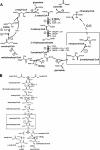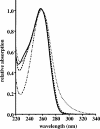Mesaconyl-coenzyme A hydratase, a new enzyme of two central carbon metabolic pathways in bacteria
- PMID: 18065535
- PMCID: PMC2238226
- DOI: 10.1128/JB.01621-07
Mesaconyl-coenzyme A hydratase, a new enzyme of two central carbon metabolic pathways in bacteria
Abstract
The coenzyme A (CoA)-activated C5-dicarboxylic acids mesaconyl-CoA and beta-methylmalyl-CoA play roles in two as yet not completely resolved central carbon metabolic pathways in bacteria. First, these compounds are intermediates in the 3-hydroxypropionate cycle for autotrophic CO2 fixation in Chloroflexus aurantiacus, a phototrophic green nonsulfur bacterium. Second, mesaconyl-CoA and beta-methylmalyl-CoA are intermediates in the ethylmalonyl-CoA pathway for acetate assimilation in various bacteria, e.g., in Rhodobacter sphaeroides, Methylobacterium extorquens, and Streptomyces species. In both cases, mesaconyl-CoA hydratase was postulated to catalyze the interconversion of mesaconyl-CoA and beta-methylmalyl-CoA. The putative genes coding for this enzyme in C. aurantiacus and R. sphaeroides were cloned and heterologously expressed in Escherichia coli, and the proteins were purified and studied. The recombinant homodimeric 80-kDa proteins catalyzed the reversible dehydration of erythro-beta-methylmalyl-CoA to mesaconyl-CoA with rates of 1,300 micromol min(-1) mg protein(-1). Genes coding for similar enzymes with two (R)-enoyl-CoA hydratase domains are present in the genomes of Roseiflexus, Methylobacterium, Hyphomonas, Rhodospirillum, Xanthobacter, Caulobacter, Magnetospirillum, Jannaschia, Sagittula, Parvibaculum, Stappia, Oceanicola, Loktanella, Silicibacter, Roseobacter, Roseovarius, Dinoroseobacter, Sulfitobacter, Paracoccus, and Ralstonia species. A similar yet distinct class of enzymes containing only one hydratase domain was found in various other bacteria, such as Streptomyces species. The role of this widely distributed new enzyme is discussed.
Figures





Similar articles
-
Identifying the missing steps of the autotrophic 3-hydroxypropionate CO2 fixation cycle in Chloroflexus aurantiacus.Proc Natl Acad Sci U S A. 2009 Dec 15;106(50):21317-22. doi: 10.1073/pnas.0908356106. Epub 2009 Dec 2. Proc Natl Acad Sci U S A. 2009. PMID: 19955419 Free PMC article.
-
L-malyl-coenzyme A/beta-methylmalyl-coenzyme A lyase is involved in acetate assimilation of the isocitrate lyase-negative bacterium Rhodobacter capsulatus.J Bacteriol. 2005 Feb;187(4):1415-25. doi: 10.1128/JB.187.4.1415-1425.2005. J Bacteriol. 2005. PMID: 15687206 Free PMC article.
-
Properties of succinyl-coenzyme A:D-citramalate coenzyme A transferase and its role in the autotrophic 3-hydroxypropionate cycle of Chloroflexus aurantiacus.J Bacteriol. 2006 Sep;188(18):6460-8. doi: 10.1128/JB.00659-06. J Bacteriol. 2006. PMID: 16952935 Free PMC article.
-
Biotechnological potential of the ethylmalonyl-CoA pathway.Appl Microbiol Biotechnol. 2011 Jan;89(1):17-25. doi: 10.1007/s00253-010-2873-z. Epub 2010 Sep 30. Appl Microbiol Biotechnol. 2011. PMID: 20882276 Review.
-
How half a century of research was required to understand bacterial growth on C1 and C2 compounds; the story of the serine cycle and the ethylmalonyl-CoA pathway.Sci Prog. 2011;94(Pt 2):109-37. doi: 10.3184/003685011X13044430633960. Sci Prog. 2011. PMID: 21805909 Free PMC article. Review.
Cited by
-
The crystal structures of the tri-functional Chloroflexus aurantiacus and bi-functional Rhodobacter sphaeroides malyl-CoA lyases and comparison with CitE-like superfamily enzymes and malate synthases.BMC Struct Biol. 2013 Nov 9;13:28. doi: 10.1186/1472-6807-13-28. BMC Struct Biol. 2013. PMID: 24206647 Free PMC article.
-
A synthetic pathway for the fixation of carbon dioxide in vitro.Science. 2016 Nov 18;354(6314):900-904. doi: 10.1126/science.aah5237. Science. 2016. PMID: 27856910 Free PMC article.
-
The apparent malate synthase activity of Rhodobacter sphaeroides is due to two paralogous enzymes, (3S)-Malyl-coenzyme A (CoA)/{beta}-methylmalyl-CoA lyase and (3S)- Malyl-CoA thioesterase.J Bacteriol. 2010 Mar;192(5):1249-58. doi: 10.1128/JB.01267-09. Epub 2010 Jan 4. J Bacteriol. 2010. PMID: 20047909 Free PMC article.
-
Structural Basis for a Cork-Up Mechanism of the Intra-Molecular Mesaconyl-CoA Transferase.Biochemistry. 2023 Jan 3;62(1):75-84. doi: 10.1021/acs.biochem.2c00532. Epub 2022 Dec 19. Biochemistry. 2023. PMID: 36535006 Free PMC article.
-
Identifying the missing steps of the autotrophic 3-hydroxypropionate CO2 fixation cycle in Chloroflexus aurantiacus.Proc Natl Acad Sci U S A. 2009 Dec 15;106(50):21317-22. doi: 10.1073/pnas.0908356106. Epub 2009 Dec 2. Proc Natl Acad Sci U S A. 2009. PMID: 19955419 Free PMC article.
References
-
- Alber, B. E., and G. Fuchs. 2002. Propionyl-coenzyme A synthase from Chloroflexus aurantiacus, a key enzyme of the 3-hydroxypropionate cycle for autotrophic CO2 fixation. J. Biol. Chem. 27712137-12143. - PubMed
-
- Alber, B. E., R. Spanheimer, C. Ebenau-Jehle, and G. Fuchs. 2006. Study of an alternate glyoxylate cycle for acetate assimilation by Rhodobacter sphaeroides. Mol. Microbiol. 61297-309. - PubMed
-
- Albers, H., and G. Gottschalk. 1976. Acetate metabolism in Rhodopseudomonas gelatinosa and several other Rhodospirillaceae. Arch. Microbiol. 11145-49. - PubMed
-
- Anthony, C. 1982. The biochemistry of methylotrophs. Academic Press, London, United Kingdom.
-
- Ausubel, F. M., R. Brent, R. E. Kingston, D. D. Moore, J. G. Seidman, J. A. Smith, and K. Struhl. 1987. Current protocols in molecular biology. John Wiley and Sons, New York, NY.
Publication types
MeSH terms
Substances
LinkOut - more resources
Full Text Sources
Other Literature Sources
Molecular Biology Databases
Research Materials
Miscellaneous

